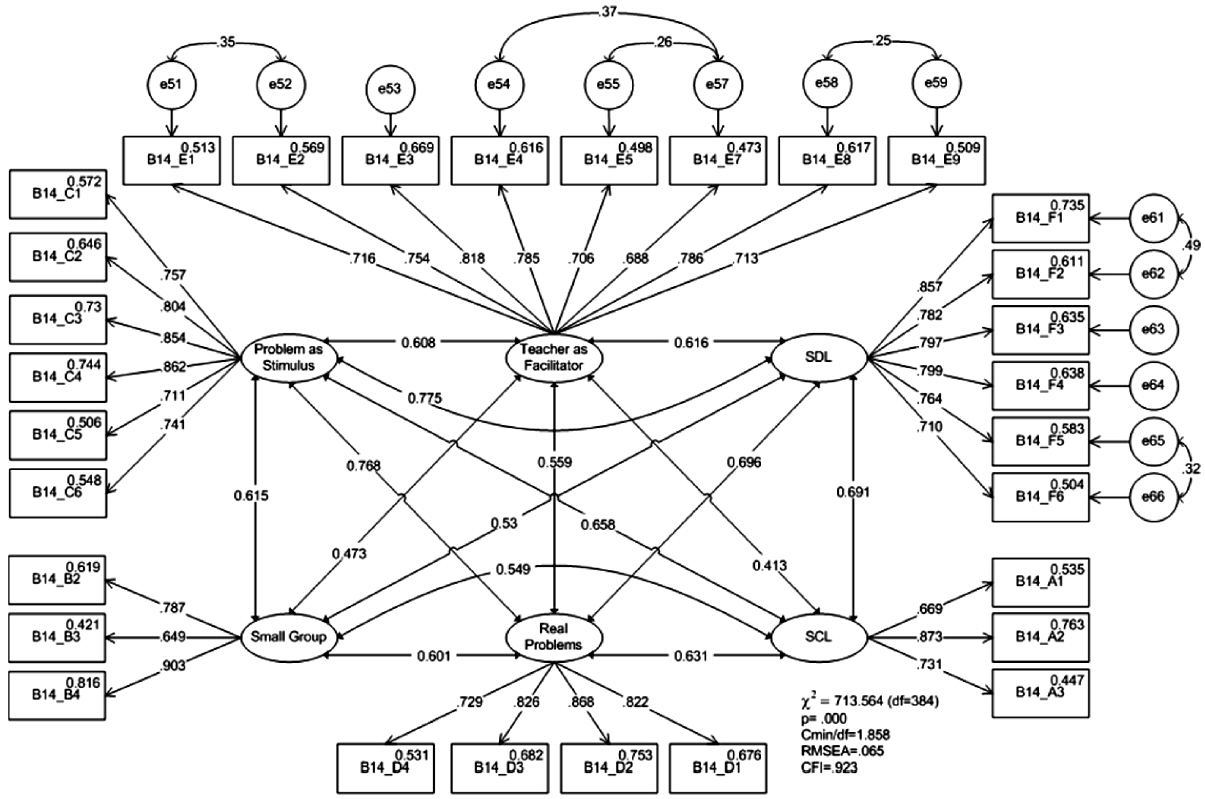J Educ Eval Health Prof.
2015;12:22. 10.3352/jeehp.2015.12.22.
The validity and reliability of a problem-based learning implementation questionnaire
- Affiliations
-
- 1Faculty of Psychology, Universitas Gadjah Mada, Yogyakarta, Indonesia. patria@ugm.ac.id
- 2International Centre for Higher Education Research Kassel, University of Kassel, Kassel, Germany.
- KMID: 2402029
- DOI: http://doi.org/10.3352/jeehp.2015.12.22
Abstract
- PURPOSE
The aim of this paper is to provide evidence for the validity and reliability of a questionnaire for assessing the implementation of problem-based learning (PBL). This questionnaire was developed to assess the quality of PBL implementation from the perspective of medical school graduates.
METHODS
A confirmatory factor analysis was conducted to assess the validity of the questionnaire. The analysis was based on a survey of 225 graduates of a problem-based medical school in Indonesia.
RESULTS
The results showed that the confirmatory factor analysis model had a good fit to the data. Further, the values of the standardized loading estimates, the squared inter-construct correlations, the average variances extracted, and the composite reliabilities all provided evidence of construct validity.
CONCLUSION
The PBL implementation questionnaire was found to be valid and reliable, making it suitable for evaluation purposes.
Keyword
MeSH Terms
Figure
Reference
-
1. Schmidt HG, Cohen-Schotanus J, Arends LR. Impact of problem-based, active learning on graduation rates for 10 generations of Dutch medical students. Med Educ. 2009; 43:211–218. http://dx.doi.org/10.1111/j.1365-2923.2008.03287.x.
Article2. Watmough S, Cherry MG, O’Sullivan H. A comparison of self-perceived competencies of traditional and reformed curriculum graduates 6 years after graduation. Med Teach. 2012; 34:562–568.
Article3. Dolmans D, Gijbels D. Research on problem-based learning: future challenges. Med Educ. 2013; 47:214–218. http://dx.doi.org/10.1111/medu.12105.
Article4. Newman M. A pilot systematic review and meta-analysis on the effectiveness of problem-based learning [Internet]. Newcastle (UK): Catherine Cookson Centre for Medical Education and Health Informatics;2003. [cited 2014 Sep 16]. Available from: http://citeseerx.ist.psu.edu/viewdoc/download?doi=10.1.1.133.6561&rep=rep1&type=pdf.5. Barrows HS. Problem-based learning in medicine and beyond: a brief overview. Wilkerson L, Gijselaers W. Bringing problem-based learning to higher education: theory and practice. San Francisco (CA): Jossey-Bass;1996. p. 3–11.6. Neville AJ. Problem-based learning and medical education forty years on. Med Princ Pract. 2009; 18:1–9. http://dx.doi.org/10.1159/000163038.
Article7. Patria B. Problem-based learning, graduates’ competencies and career success. Yogyakarta, Indonesia: Inparametric Press;2011. p. 15–21.8. Dolmans DHJM, Ginns P. A short questionnaire to evaluate the effectiveness of tutors in PBL: validity and reliability. Med Teach. 2005; 27:534–538. http://dx.doi.org/10.1080/01421590500136477.
Article9. Brandes D, Ginnis P. A guide to student-centred learning. London (UK): Basil Blackwell Ltd.;1986.10. Steinert Y. Student perceptions of effective small group teaching. Med Educ. 2004; 38:286–293. http://dx.doi.org/10.1046/j.1365-2923.2004.01772.x.
Article11. Majoor GD, Schmidt HG, Snellen-Balendong HAM, Moust JHC, Stalenhoef-Halling B. Construction of problems for problem-based learning. Nooman Z, Schmidt HG, Ezzat ES. Innovation in medical education. New York (NY): Springer;1990. p. 114–122.12. Marchais JED. A Delphi technique to identify and evaluate criteria for construction of PBL problems. Med Educ. 1999; 33:504–508. http://dx.doi.org/10.1046/j.1365-2923.1999.00377.x.
Article13. Savery JR. Overview of problem-based learning: definitions and distinctions. Interdiscip J Probl based Learn. 2006; 1:9–20. http://dx.doi.org/10.7771/1541-5015.1002.14. Brockett RG. Self-directed learning readiness and life satisfaction among older adults. Ann Arbor (MI): University Microfilms International;1982. p. 237.15. Barrows HS. Problem-based learning applied to medical education. Springfield (IL): Southern Illinois University School of Medicine;2000.16. Hair J, Black W, Babin B, Anderson R. Multivariate data analysis. 7th ed. Harlow (UKJ): Pearson Education Limited.;2013. p. 752.17. Zinbarg RE, Yovel I, Revelle W, McDonald RP. Estimating generalizability to a latent variable common to all of a scale’s indicators: a comparison of estimators for ωh. Appl Psychol Meas. 2006; 30:121–144. http://dx.doi.org/10.1177/0146621605278814.
Article18. Brown TA. Confirmatory factor analysis for applied research. New York (NY): The Guilford Press;2006; 475.19. Podsakoff PM, MacKenzie SB, Lee JY, Podsakoff NP. Common method biases in behavioral research: a critical review of the literature and recommended remedies. J Appl Psychol. 2003; 88:879–903. http://dx.doi.org/10.1037/0021-9010.88.5.879.
Article
- Full Text Links
- Actions
-
Cited
- CITED
-
- Close
- Share
- Similar articles
-
- An Student's Evaluation of the Implementation of Problem-Based Learning
- An Implementation and an Evaluation on the Problem-based Learning in Occupational & Environmental Medicine(OEM)
- Implementation of a Problem-Based Learning Program Combined with Team-Based Learning
- Implementation of Problem-based Learning to Established Medical Schools with Insufficient Resources
- Perspectives of Nurse Students on Problem-Based Learning: Learning Experience in Pediatric Nursing


